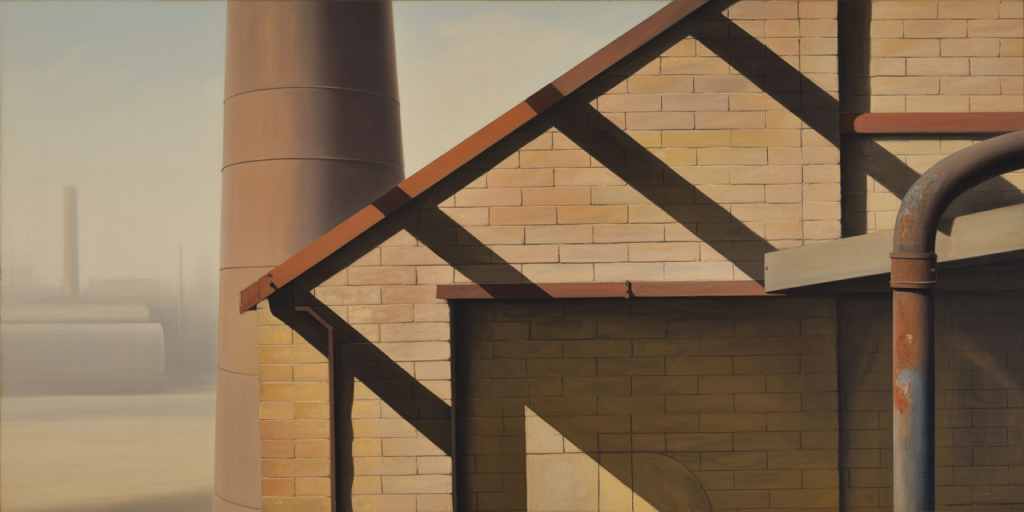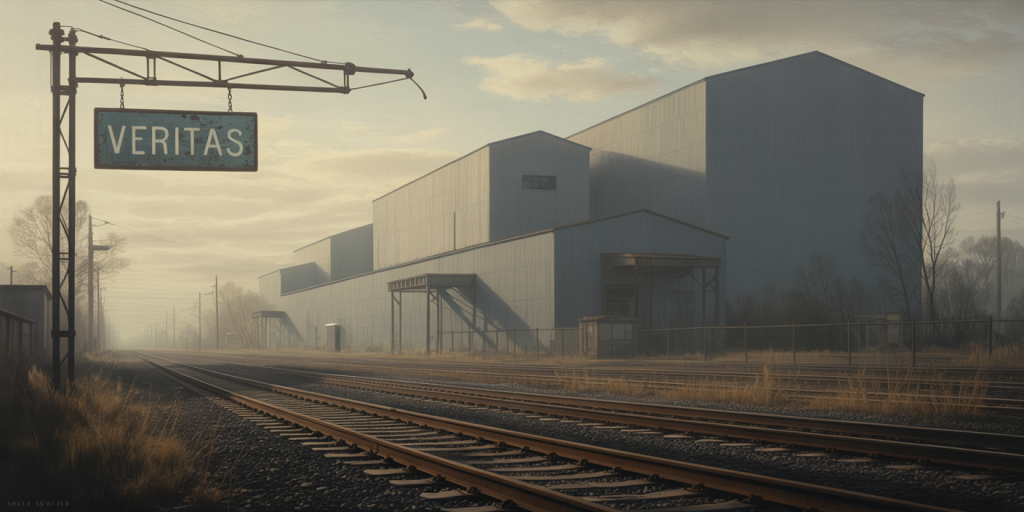Between Tracks and Silences: The Industrial Melancholy of Charles Sheeler
There are paintings where silence hums like a machine long since powered down. Charles Sheeler does not paint industry as power, nor modernity as noise. Instead, he gives us the afterglow — the hush after production, the steel skeleton of progress stripped of its pride. His vision is not of man’s conquest of matter, but of matter enduring long after man has left the frame.
In Between Tracks and Silences, the world seems emptied of voices. The factory no longer roars. The train no longer comes. Yet everything remains: the tracks, the angles, the iron grid of a world built to last beyond its own story. This is the poetry of abandonment, the lyricism of precision. It is not nostalgia — it is quiet reverence.

Poetic Table of Contents
- The Silence That Remains After Progress
- Rails Without Destination
- Architecture of the Absent Worker
- Iron Beams and Emotional Weight
- Where Geometry Becomes Ghost
- Dust Settled on Precision
- Stillness with Steel Bones
- Light Without Warmth
- The Monochrome of Memory
- When Machines No Longer Breathe
- The Psychology of Grids
- Steel That Doesn’t Speak
- Factories as Forgotten Temples
- Aesthetic of the Functional
- Shadows of the Assembly Line
- Melancholy in Symmetry
- The Sound of Industrial Absence
- Time Held by Rivets
- The Beauty of the Uninhabited
- Silence Built with Intention
The Silence That Remains After Progress
In Sheeler’s industrial landscapes, silence is not an absence. It is a structure, as strong as girders, as present as concrete. It fills the space between buildings, curls under overpasses, and presses gently on the tracks.
This is not the noise of productivity, but its shadow. The echo of what once moved through these spaces lingers. It does not mourn — it observes.
Rails Without Destination
The train tracks, central and clean, stretch toward a vanishing point. Yet no train is visible. The rails do not promise arrival. They imply departure — or perhaps nothing at all.
They are lines drawn in steel across memory. Like veins that no longer carry blood, they remain — vital in structure, obsolete in purpose.
Architecture of the Absent Worker
No human figure interrupts the geometry. Yet their trace is everywhere: in the alignment of bricks, the repetition of windows, the symmetry that obeys production.
Sheeler paints the ghost of labor. Not the worker’s body, but the architecture shaped by routine, shaped by demand. It is a temple to human industry, now hollow with reverence.
Iron Beams and Emotional Weight
The weight of iron here is emotional, not just physical. The beams do not support — they burden. They carry not machinery, but memory.
Every structure becomes symbolic: verticals of permanence, horizontals of distance. The composition is not just a city — it’s a diagram of restraint.
Where Geometry Becomes Ghost
Sheeler’s greatest talent lies in converting the mechanical into the metaphysical. Straight lines begin to haunt. Rectangles loom like unresolved thoughts.
There is precision, yes — but also presence. The ghost in the geometry is not imagined. It’s felt, in the quiet stare the painting returns.
Dust Settled on Precision
The painting’s surface seems coated in a layer of dust — not in texture, but in tone. Everything is too clean, too exact, and therefore old.
This isn’t the newness of progress. It’s the aging of its ideals. The dust is conceptual, a metaphor for how quickly the future becomes the past.
Stillness with Steel Bones
Stillness here is not peace. It is architecture without breath. The buildings are skeletons, the beams are bones. They do not decay — they endure.
But that endurance is empty. They hold nothing. Their only inhabitant is the viewer’s reflection, projected into the silence.
Light Without Warmth
Light in Sheeler’s world is cold. It does not bless — it exposes. It sharpens the angles, whitens the bricks, slices the shadows.
This is not the light of sunrise or hearth. It is the fluorescent hum of modernity. A light that tells, not feels. A light that forgets to comfort.
The Monochrome of Memory
Color exists, but barely. Muted earth tones. Off-whites. Industrial grays. Sheeler’s palette whispers rather than declares.
This restraint is memory. It allows us to project, to imagine the world in motion, even as it holds us still. These are the shades of photographs aged in drawers.
When Machines No Longer Breathe
The machinery is implied, not shown. You sense the turbines, the belts, the tools — all silenced. The lungs of production have collapsed.
Yet the structure remains — like an empty body after spirit departs. This is industrial memento mori. Not death, but a cooling. A stillness after long labor.

The Psychology of Grids
Grids dominate. They organize windows, divide walls, direct space. But they also confine. They box in air, thoughts, memory.
The grid becomes psychological — a symbol of order that contains the chaos of history. A modernist impulse rendered as prison and poetry.
Steel That Doesn’t Speak
Steel is not shown, but felt. Its silence is louder than any siren. Its strength now only serves as contrast to the human softness that has vanished.
This steel does not bend, does not break. It simply stays. But staying, here, is not triumph. It is testament. It is burden.
Factories as Forgotten Temples
Each building resembles a sacred site. The repetition of windows echoes liturgy. The elevation of smokestacks resembles steeples.
Sheeler turns factory into cathedral — not in grandeur, but in solemnity. The religion is work. The altar, a drafting table. The prayer, unspoken.
Aesthetic of the Functional
Function defines form — but form, in Sheeler’s hands, becomes aesthetic. The angle of a pipe, the distance between columns, the framing of a rail.
Utility becomes visual poetry. Even the mundane is granted rhythm. The composition is exact, but the effect is elegiac.
Shadows of the Assembly Line
Shadows fall with precision, as if painted by machines. They repeat like products. They line up like workers.
But there are no workers. Only the echo of their schedules. Only the habit of light, remembering where bodies used to stand.
Melancholy in Symmetry
Symmetry usually brings calm. Here, it brings melancholy. The repetition is not soothing, but sorrowful — like a lullaby no one sings anymore.
Each mirrored window reflects nothing. The doors are closed, not to keep out — but because there is nothing left to enter.
The Sound of Industrial Absence
This painting sounds like an engine long turned off. Like a siren faded to memory. Like footsteps on metal that echo only in imagination.
It is the sound of stopped time. Of a building waiting. Of silence settling like rust on steel.
Time Held by Rivets
Time does not pass in this painting. It is held, bolted into place. Every rivet is a second. Every seam is an hour.
Sheeler’s world is timeless not in eternity — but in suspension. It waits. And in that waiting, it speaks.
The Beauty of the Uninhabited
There is beauty in this vacancy. Not sadness, not fear — but revelation. We see the structures without distraction. We feel their shape without use.
It is the architecture of abandonment as honesty. The city no longer performs. It simply exists. And in that, it becomes more human.

Silence Built with Intention
Sheeler builds silence. Not as a byproduct, but as purpose. Each angle is a hush. Each shadow is a pause. Each brick, a quiet decision.
The silence is not absence. It is presence. A presence that asks nothing, offers no conclusion — only stillness.
FAQ – Questions and Answers
Who was Charles Sheeler?
Charles Sheeler was an American painter and photographer, a leading figure in Precisionism, known for his exacting depictions of industrial and architectural subjects with an underlying sense of emotional quietude.
What is Precisionism?
Precisionism was a modernist art movement focused on clean lines, geometric form, and industrial subjects. It combined realism with abstraction, emphasizing structure over emotion — though Sheeler added subtle feeling through restraint.
Is this work a celebration or critique of industry?
Neither and both. Sheeler neither glorifies nor condemns. Instead, he observes — recording the power and solitude of industrial forms with contemplative reverence.
Why are there no people in his industrial scenes?
Their absence intensifies the mood. It turns function into form, memory into mood. The viewer becomes the only presence, invited to fill the quiet.
What emotions does this painting evoke?
Melancholy, stillness, nostalgia, and wonder. It evokes the complex legacy of modernity — its triumphs and its silence.
Final Reflections – What Remains Between the Lines
Charles Sheeler does not give us answers. He gives us space — to pause, to breathe, to feel the weight of industry when its engines rest. In Between Tracks and Silences, we walk through absence and discover presence.
There is no drama here, no climax — only the slow hush of a world built with ambition, now returned to stillness. Yet in that stillness, Sheeler finds something rare: dignity without movement, beauty without voice, memory without lament.
This is not the end of industry — it is its afterimage, caught in pigment and patience, and held like light on steel.
